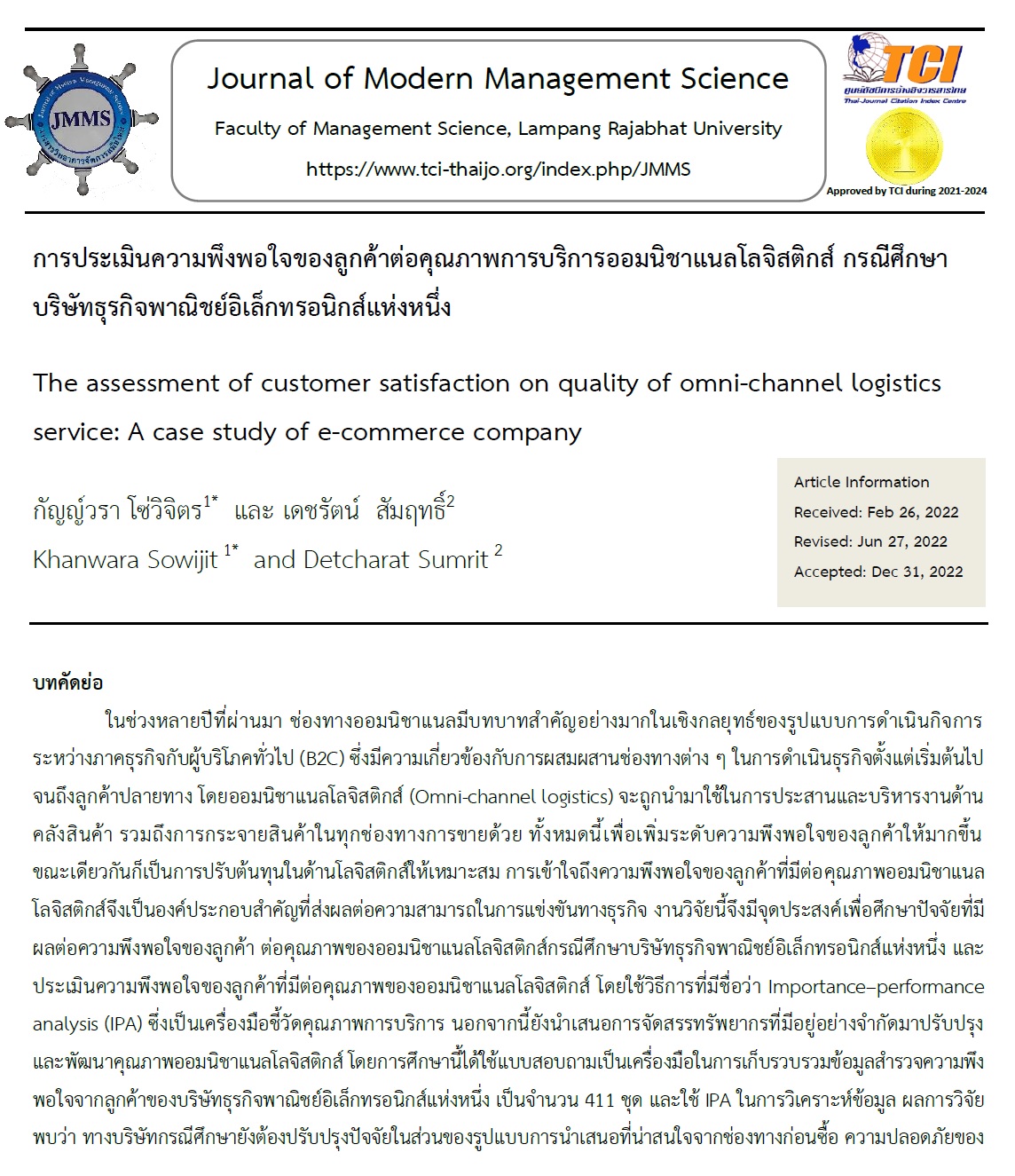The assessment of customer satisfaction on quality of omni-channel logistics service: A case study of e-commerce company
Main Article Content
Abstract
In recent years, omnichannel logistics has played an important strategic role in the business- to-customer (B2C) process, relating to multi-service channel delivery to end customers. Omnichannel logistics is a system used for inventory coordination and management, including distribution across all sales channels. As a result, it enhances customer satisfaction while optimizing the logistics cost. Understanding customers' satisfaction when using omnichannel logistics is a key component that affects business competitiveness. The objective of this research is to study the factors affecting customer satisfaction when using omnichannel logistics. To assess customer satisfaction with omnichannel logistics, this case study uses Importance–performance analysis (IPA) which is a useful service quality assessment tool. This study also proposes resource management techniques to improve and develop the quality of omni-channel logistics. A questionnaire was used to collect 411 customer satisfaction survey forms from a large e-commerce company and used IPA technique to analyze the data. The finding showed that they need to improve both the presentation style for the pre-purchase channels and post-purchase product safety, and employee quality in the customer service of automatic purchasing systems according to the calculations based on resource allocation.
Article Details

This work is licensed under a Creative Commons Attribution-NonCommercial-NoDerivatives 4.0 International License.
The article must be considered and accepted for publication by the editorial board of the Faculty of Management Science, Lampang Rajabhat University. The articles have been reviewed by a peer (peer review) and the author must update according to the suggestion if available before publication. Articles that are not considered the editorial team will inform the results of the consideration but will not send the original to the author.
JMMS is the Faculty of Management Science journal, Lampang Rajabhat University. Jmms published both print and online editions. We allow the use of articles for academic use under the scope of copyright law.
References
Adivara, B., Hüseyinoğlu, I.Y. & Christopher, M. (2019). A quantitative performance management framework for assessing omnichannel retail supply chains. Journal of Retailing and Consumer Services, 48, 257–269.
Akhtar, N., Akhtar, M.N., Usman, M., Ali, M. & Siddiqi, U.I. (2020). COVID-19 restrictions and consumers psychological reactance toward offline shopping freedom restoration. The Service Industries Journal, 40(14), 891-913.
Cheng, C., Tsai, M. & Lin, S. (2013). Developing strategies for improving the service quality of casual-dining restaurants: New insights from integrating IPGA and QFD analysis. Total Quality Management & Business Excellence, 26(4), 415-429.
Deng, W., Kuo, Y. & Chen, W. (2011). Revised importance–performance analysis: three-factor theory and benchmarking. The Service Industries Journal, 28(1), 37-51.
Frasquet, M., Mollá, A., & Ruiz, E. (2015). Identifying patterns in channel usage across the search, purchase and post-sales stages of shopping. Electronic Commerce Research and Applications, 14(6), 654-665.
Gao, L.X., Melero, I. & Sese, F.J. (2019). Multichannel integration along the customer journey: a systematic review and research agenda. The Service Industries Journal, 40(1), 1-32.
Huang, W.Y. & Dubinsky A.J. (2013). Measuring customer pre-purchase satisfaction in a retail setting. The Service Industries Journal, 34(3), 212-229.
Konus, U., Verhoef, P.C. & Scott, N.A. (2008). Multichannel Shopper Segments and Their Covariates. Journal of Retailing, 84(4), 398-413.
Konus, U., Verhoef, P.C. & Scott, N.A. (2014). The effect of search channel elimination on purchase incidence, order size and channel choice. International Journal of Research in Marketing, 31(1), 49-64.
Li, H., Li, W., Wang, L. & Lv, L. (2020). Public satisfaction evaluation of urban water environment treatment public-private partnership project: A case study from China. International Journal of Building Pathology and Adaptation, 39(2), 407-432.
Li, Z., Wang, D., Yang, W. & Jin, H. (2022). Price, online coupon, and store service effort decisions under different omnichannel retailing models. Journal of Retailing and Consumer Services, 64.
Min, S., Zhou, M., Kim, D. & Kim, J. (2013). Assessing the e-Service Quality of Sellers in an Industrial e-Marketplace. Journal of Promotion Management, 19(5), 556-582.
Mosquera, A., Ayensa, E.J., Pascual, C.O. & Murillo, Y.S. (2019). Omnichannel Shopper Segmentation in the Fashion Industry. Journal of Promotion Management, 25(5), 681-699.
Neslin A. Scott. (2022). The omnichannel continuum: Integrating online and offline channels along the customer journey. Journal of Retailing, 56(1), 111-132
Nunnally, J.C. (1978). Psychometric Theory (2nd ed.). New York: McGraw-hill.
Schreiner, T. & Baier, D. (2021). Online retailing during the COVID-19 pandemic: consumer preferences for marketing actions with consumer self-benefits versus other-benefit components. Journal of Marketing Management, 37(18), 1866-1902.
Schröder, H. & Zaharia, S. (2008). Linking multi-channel customer behavior with shopping motives: An empirical investigation of a German retailer. Journal of Retailing and Consumer Services, 15(6), 452-468.
Singh, S. & Jang, S. (2022). Search, purchase, and satisfaction in a multiple-channel environment: How have mobile devices changed consumer behaviors?. Journal of Retailing and Consumer Services, 65(3),
Tueanrat, Y., Papagiannidis, S. & Alamanos, E. (2021). A conceptual framework of the antecedents of customer journey satisfaction in omnichannel retailing. Journal of Retailing and Consumer Services, 61,
Vakulenko, Y., Shams, Poja., Hellström, D. & Hjort, K. (2019). Service innovation in e-commerce last mile delivery: Mapping the e-customer journey. Journal of Business Research, 101, 461-468.
Verhoef, P.C., Kannan, P.K. & Inman, J.J. (2015). From Multi-Channel Retailing to Omni-Channel Retailing: Introduction to the Special Issue on Multi-Channel Retailing. Journal of Retailing, 91(2), 174-181.
Verhoef, P.C., Scott, N.A. & Vroomen, B. (2007). Multichannel customer management: Understanding the research-shopper phenomenon. International Journal of Research in Marketing, 24(2), 129-148.
Xun, X. & Jackson, J.E. (2019). Investigating the influential factors of return channel loyalty in omni-channel retailing. International Journal of Production Economics, 216, 118-132.
Zhang, J., Xub, Q. & He, Y. (2018). Omnichannel retail operations with consumer returns and order cancellation. Transportation Research Part E: Logistics and Transportation Review, 118, 308-324.


